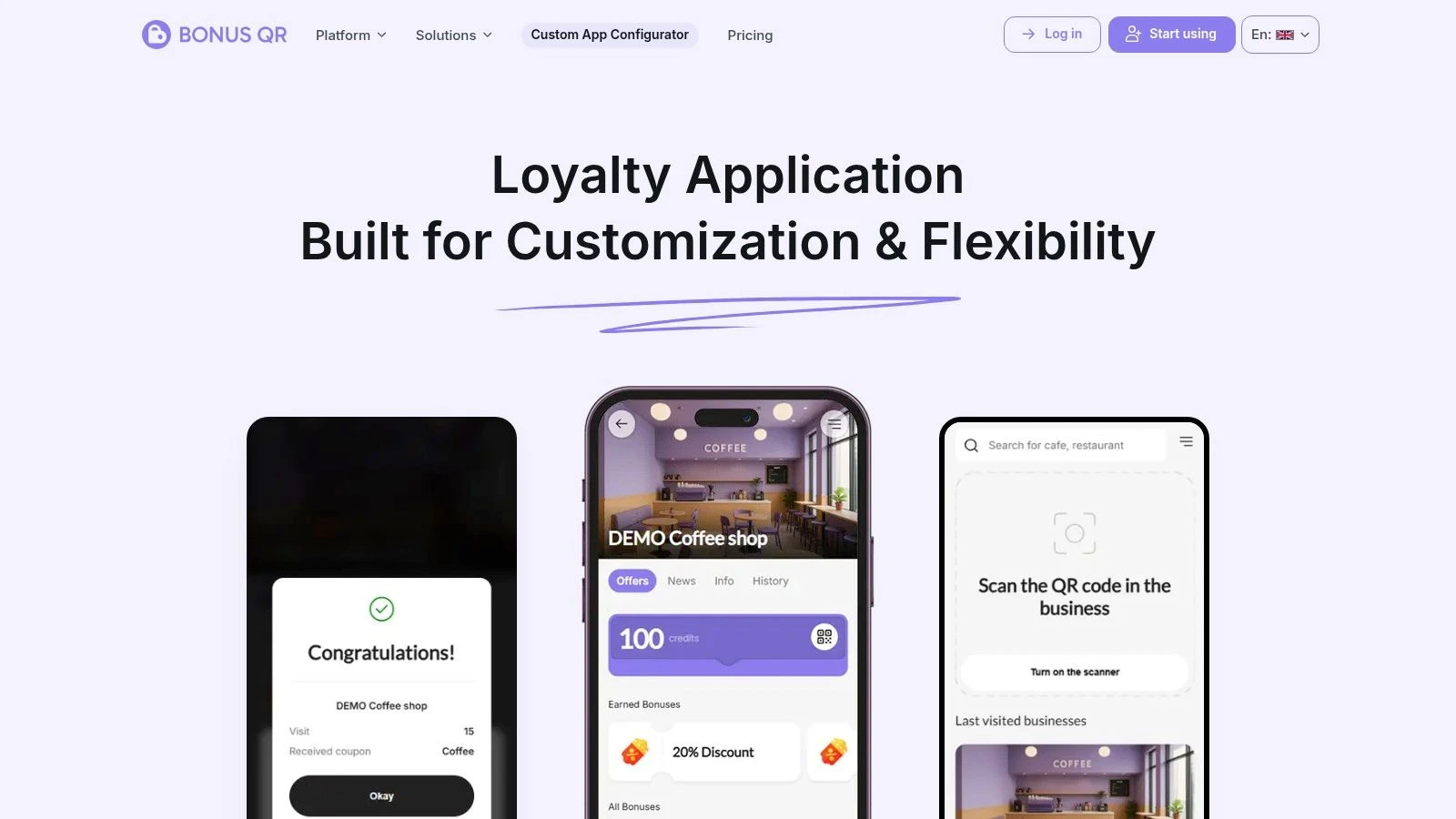In today's competitive market, repeat customers are the lifeblood of any small business, from local cafés to bustling salons. Turning a one-time visitor into a loyal advocate requires a smart rewards system that goes beyond the traditional paper punch card. Modern loyalty programs are digital, personalized, and powerful tools for growth. This guide moves past theory to showcase actionable customer loyalty program examples and the platforms that make them possible.
We will dissect what makes each one effective, providing you with the strategic insights and replicable tactics needed to build a program that truly works. A strong loyalty program is one of the most effective customer retention strategies available, helping you cultivate lasting relationships and reduce churn. We'll explore a variety of tools, from dedicated apps like BonusQR designed for simplicity, to broader marketplaces that offer a wealth of inspiration.
This listicle is designed to be a practical resource for small business owners. For each platform and resource, you'll find a detailed analysis, screenshots to illustrate key features, and direct links to help you get started immediately. Our goal is to help you find the best solution to not only retain customers but also boost your bottom line.
1. BonusQR
BonusQR secures its top position by offering a remarkably powerful and flexible digital loyalty platform specifically engineered for small businesses. It provides an all-in-one solution that moves beyond simple punch cards, allowing businesses like coffee shops, salons, and local retail stores to build sophisticated, multi-layered loyalty programs without requiring complex hardware or point-of-sale (POS) integration. This accessibility makes it a premier customer loyalty program example for entrepreneurs seeking enterprise-level features on a small business budget.
The platform's core strength lies in its profound customizability. Business owners are not locked into a single reward model. Instead, they can design a hybrid program that truly reflects their brand and customer behavior, combining elements like digital stamp cards, points accumulation, cashback rewards, and tiered membership levels. This versatility ensures the program remains engaging and valuable to a diverse customer base.
Strategic Breakdown: Key Strengths
BonusQR distinguishes itself through a strategic blend of simplicity and advanced marketing automation. The setup process is exceptionally fast, taking just a few minutes to get a program live. Customers participate by simply scanning a QR code, which eliminates the friction of downloading yet another app or carrying a physical card, as it integrates directly with Google and Apple Wallets.
Beyond rewards, its built-in marketing tools are a significant advantage. The platform enables automated communication via push notifications and email, allowing you to send targeted promotions, birthday coupons, or event announcements. This proactive engagement transforms the loyalty program from a passive reward system into a dynamic communication channel that keeps your business top of mind.
Actionable Takeaways for Your Business
- Implement a Hybrid Model: Don't limit yourself to one reward type. Use BonusQR to create a program where customers earn points for purchases (encouraging larger spends) and receive digital stamps for visits (encouraging frequency).
- Leverage Birthday Automation: The "set it and forget it" birthday coupon feature is a powerful tool for generating goodwill and driving a guaranteed annual visit from your most loyal customers.
- Use Analytics to Refine Offers: Regularly check the platform's dashboard to see which rewards are being redeemed most often. Use this data to phase out unpopular offers and double down on what your customers truly value.
Platform Details at a Glance
| Feature | Details |
|---|---|
| Pricing | Free basic plan available. Premium tiers offer enhanced features like white-labeling and custom apps with affordable monthly and one-time fees. |
| Best For | Coffee shops, restaurants, salons, gyms, and independent retail stores seeking a powerful, easy-to-manage digital solution. |
| Key Differentiator | The ability to mix multiple loyalty program types (stamps, points, cashback) with robust marketing automation without needing POS integration. |
Website: https://bonusqr.com
2. Shopify App Store - Customer Loyalty category
For entrepreneurs operating on the Shopify platform, the best place to find real-world customer loyalty program examples isn't a blog post; it's a marketplace. The Shopify App Store's Customer Loyalty category is a powerful research tool disguised as a software hub. It features over 400 apps dedicated to rewards, referrals, wishlists, and more, providing a direct line of sight into the strategies successful merchants are using right now.
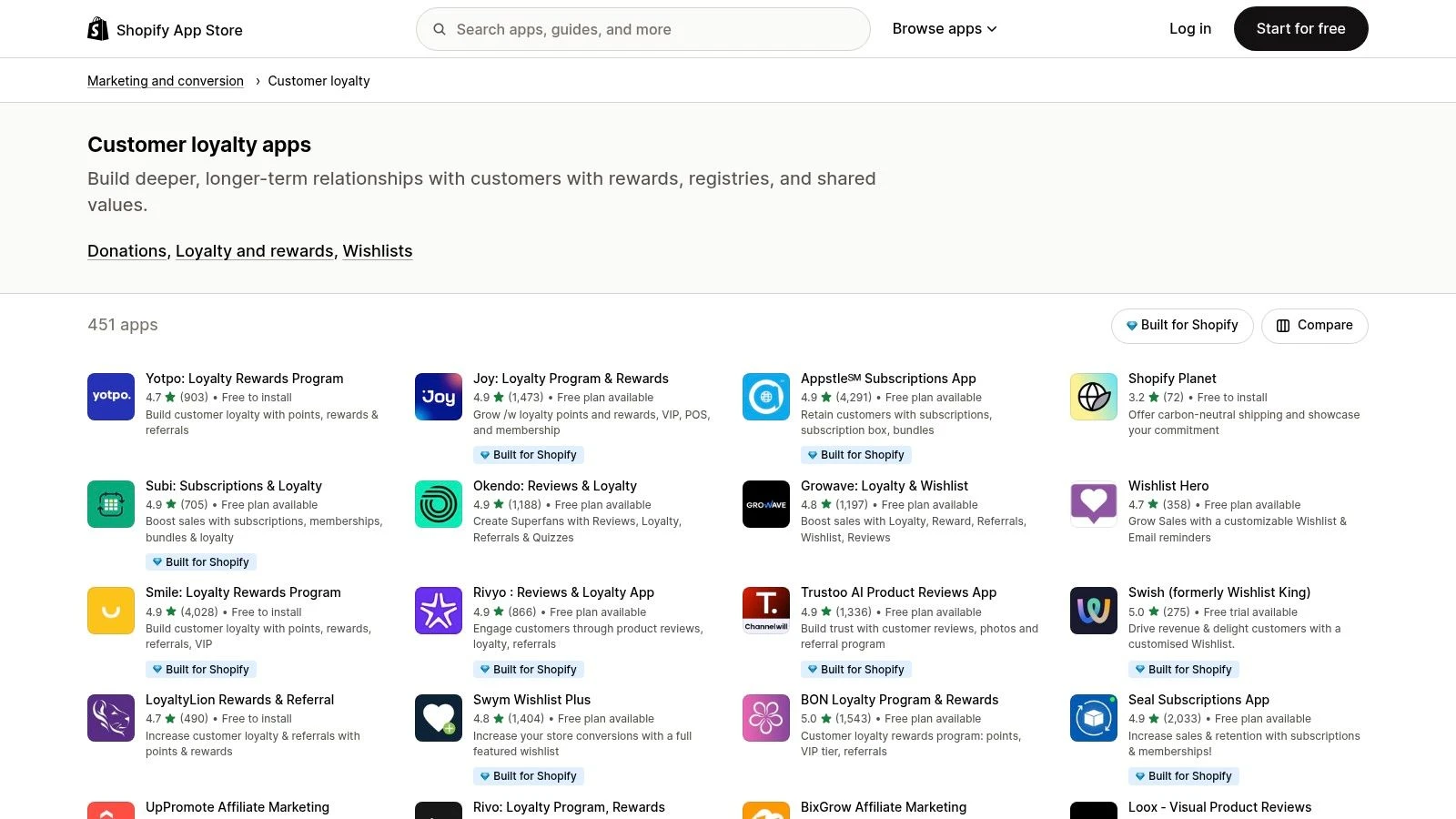
Unlike theoretical articles, this platform offers a hands-on learning experience. You can see how loyalty programs are structured through app screenshots, live demos, and detailed feature lists. Reading user reviews provides unfiltered feedback on what works and what doesn't, offering invaluable insights for your own strategy.
Strategic Breakdown & Takeaways
The real value of this resource is its ability to help you reverse-engineer a successful program before spending a dime. By analyzing the top-rated apps and their showcased examples, you can identify trends and best practices.
- Actionable Tip: Use the filters to sort by "Most popular" to see what the majority of merchants use. Then, visit the app pages and look for storefront examples to see these programs in action.
- Pricing Insights: Most apps offer a free plan or a trial period. This lets you experiment with different loyalty models (e.g., points for purchases, tiered rewards, birthday bonuses) with minimal financial risk.
- Unique Feature: The "Built for Shopify" badge indicates apps that meet high standards for performance, security, and user experience, helping you quickly identify quality solutions.
This direct-from-the-source approach provides a more practical education than generic case studies. You can find more unique loyalty program examples and see how different platforms stack up by exploring additional resources. Read more about successful loyalty programs and their implementation on BonusQR.com.
Pros & Cons
| Pros | Cons |
|---|---|
| Direct access to hundreds of real-world loyalty program ideas | Best suited for Shopify merchants; less relevant otherwise |
| Free plans/trials allow for low-risk testing and learning | Choice overload can be overwhelming without a clear goal |
| User reviews offer honest feedback on effectiveness and UX | App quality can vary significantly between vendors |
Website: https://apps.shopify.com/categories/marketing-and-conversion-customer-loyalty
3. Square Loyalty
For small businesses, especially in retail and food service, the most effective customer loyalty program examples are often the ones that are easiest to manage. Square Loyalty excels by integrating directly into the Square Point of Sale (POS) system, creating a seamless experience for both the business and the customer. It eliminates the need for physical cards or separate apps, allowing customers to enroll and earn rewards using just their phone number at checkout.
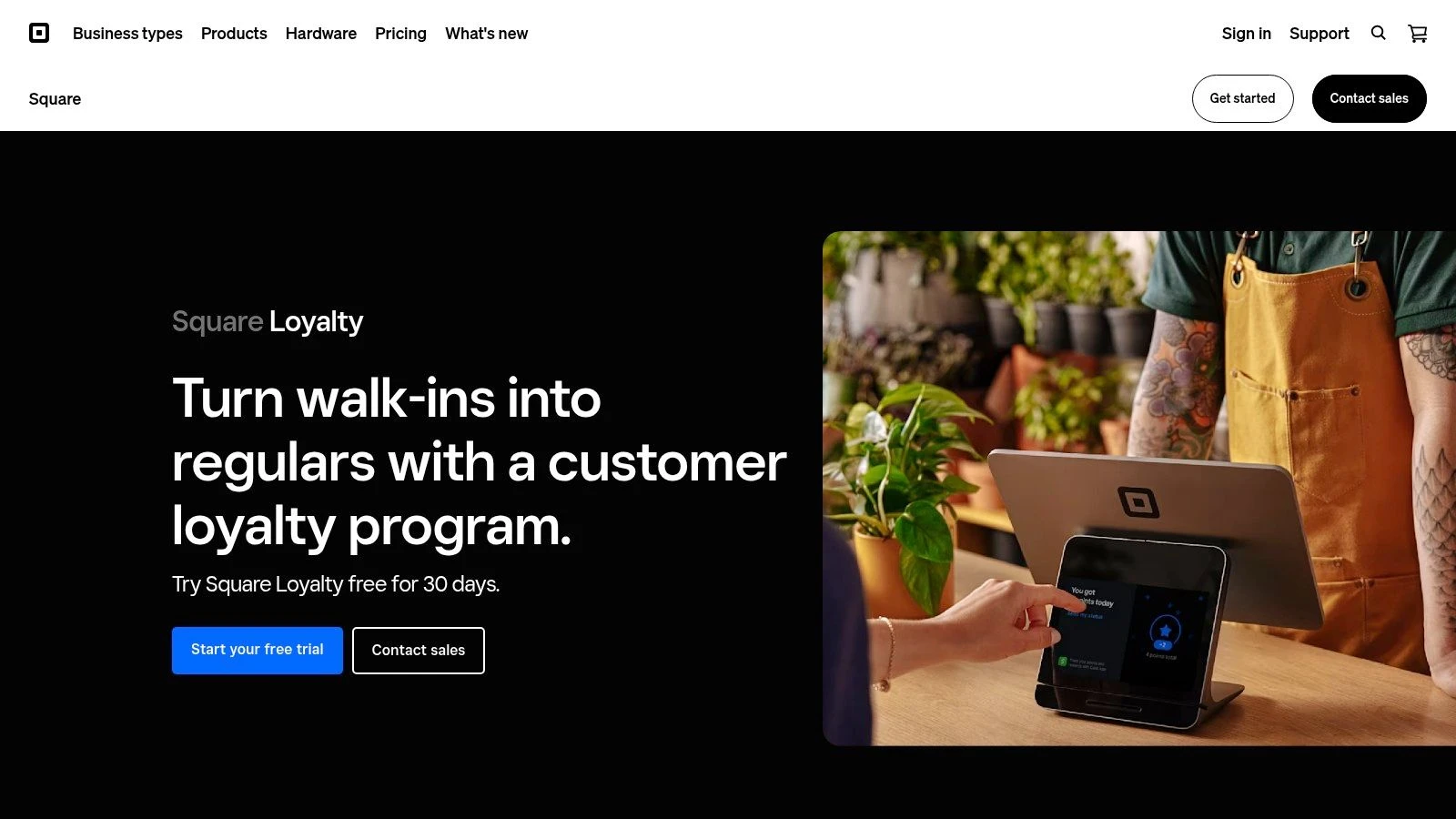
This native integration is its key differentiator. Businesses already using Square can launch a program in minutes without any technical expertise. The platform is designed for speed and simplicity, making it ideal for high-traffic environments like coffee shops or quick-service restaurants where delaying a transaction line is not an option.
Strategic Breakdown & Takeaways
The genius of Square Loyalty lies in its frictionless approach. By tying loyalty to a phone number, it removes a major barrier to participation and makes tracking automatic. This simplicity allows business owners to focus on setting meaningful rewards rather than managing complex software.
- Actionable Tip: Start with a simple reward that is easy to understand and desirable, like "Earn 100 points, get a free coffee." This clarity encourages initial sign-ups and helps customers immediately grasp the value.
- Pricing Insights: Square’s pricing is based on the number of loyalty visits per month, starting at $45/month per location after a 30-day free trial. This usage-based model means you pay more only as the program proves its success in bringing customers back.
- Unique Feature: The omnichannel capability is a significant advantage. Points earned in-store are automatically synced and can be redeemed through a Square Online store, creating a unified experience for customers who shop both in-person and online.
This all-in-one system provides a powerful, accessible entry point into customer retention. You can learn more about how loyalty program apps increase customer retention on BonusQR.com to explore further strategies.
Pros & Cons
| Pros | Cons |
|---|---|
| Fast to launch for existing Square users with no development | Primarily works well within the Square ecosystem |
| Clear, usage-based pricing aligned to customer participation | Advanced customization options are limited compared to suites |
| Simple in-store enrollment and a smooth customer experience | Less suitable for businesses not using Square for payments |
Website: https://squareup.com/loyalty
4. Yotpo Loyalty & Referrals
Yotpo offers a comprehensive loyalty and referrals platform that moves beyond generic templates, providing a rich library of case studies that serve as excellent customer loyalty program examples. Instead of just showing features, Yotpo details the specific strategies and measurable outcomes that brands like Princess Polly and Parks Project have achieved, giving business owners a clear blueprint for success. This focus on data-backed results makes it a powerful educational tool for anyone serious about retention marketing.
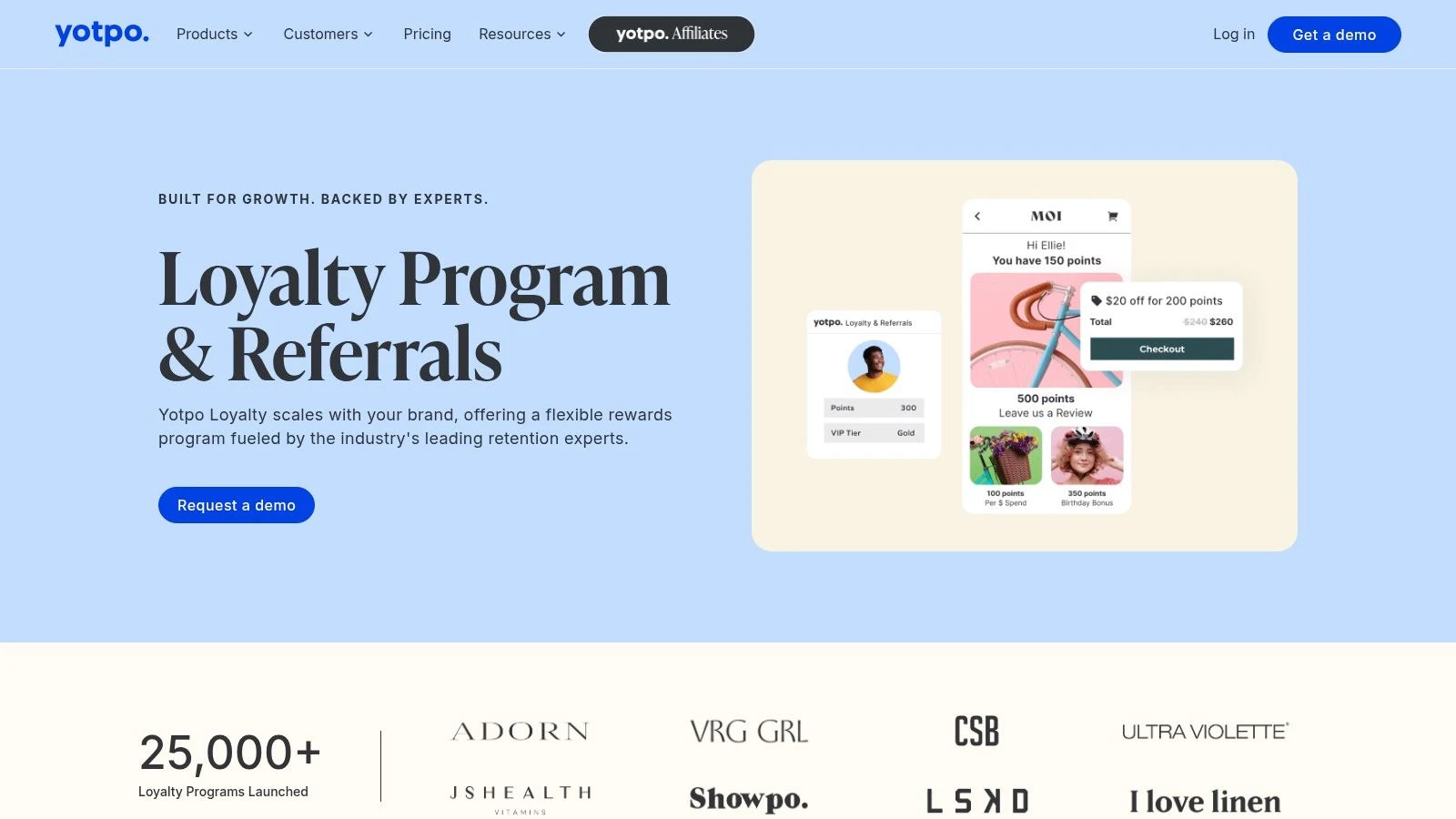
This platform excels by integrating loyalty with other crucial marketing channels like reviews and SMS, creating a unified customer experience. Users can explore pre-built campaign ideas for VIP tiers, points systems, and referral bonuses, all supported by real-world examples showing the return on investment. The free plan for stores with fewer than 100 monthly orders provides an accessible entry point for small businesses.
Strategic Breakdown & Takeaways
The primary value of Yotpo is learning from its extensive library of data-rich case studies before committing to a paid plan. By analyzing how successful brands structure their programs, you can identify proven tactics and forecast potential results for your own business.
- Actionable Tip: Dive into their case study library and filter by your industry (e.g., Food & Beverage, Health & Beauty). Pay close attention to the specific campaigns they ran and the lift in repeat purchase rate or customer lifetime value.
- Pricing Insights: The free plan is a great starting point, but be mindful that pricing scales with order volume. Check the Shopify App Store listing for clear details on pricing tiers and potential overage charges to budget effectively as you grow.
- Unique Feature: Yotpo's integrated ecosystem is its biggest strength. You can reward customers with points for leaving reviews or signing up for SMS alerts, creating a powerful, self-reinforcing loop of engagement and user-generated content.
This evidence-based approach helps de-risk the process of launching a loyalty program, allowing you to build a strategy based on what is already proven to work in your specific niche.
Pros & Cons
| Pros | Cons |
|---|---|
| Strong, real-world examples with measurable ROI to learn from | Pricing scales with order volume and can incur overage charges |
| Integrated ecosystem combines loyalty, reviews, and SMS | Complex setup may be time-consuming for advanced features |
| Scalable plans and a free tier to fit growing businesses | Best suited for ecommerce; less direct for service-based businesses |
Website: https://www.yotpo.com/platform/loyalty/
5. Smile.io
For small and medium-sized ecommerce businesses, Smile.io offers one of the most accessible entry points into building a sophisticated rewards system. It’s a dedicated loyalty platform that integrates seamlessly with major ecommerce hosts like Shopify, Wix, and BigCommerce. Smile.io focuses on three core pillars: points, referrals, and VIP tiers, making it a go-to resource for seeing straightforward customer loyalty program examples implemented by growing brands.
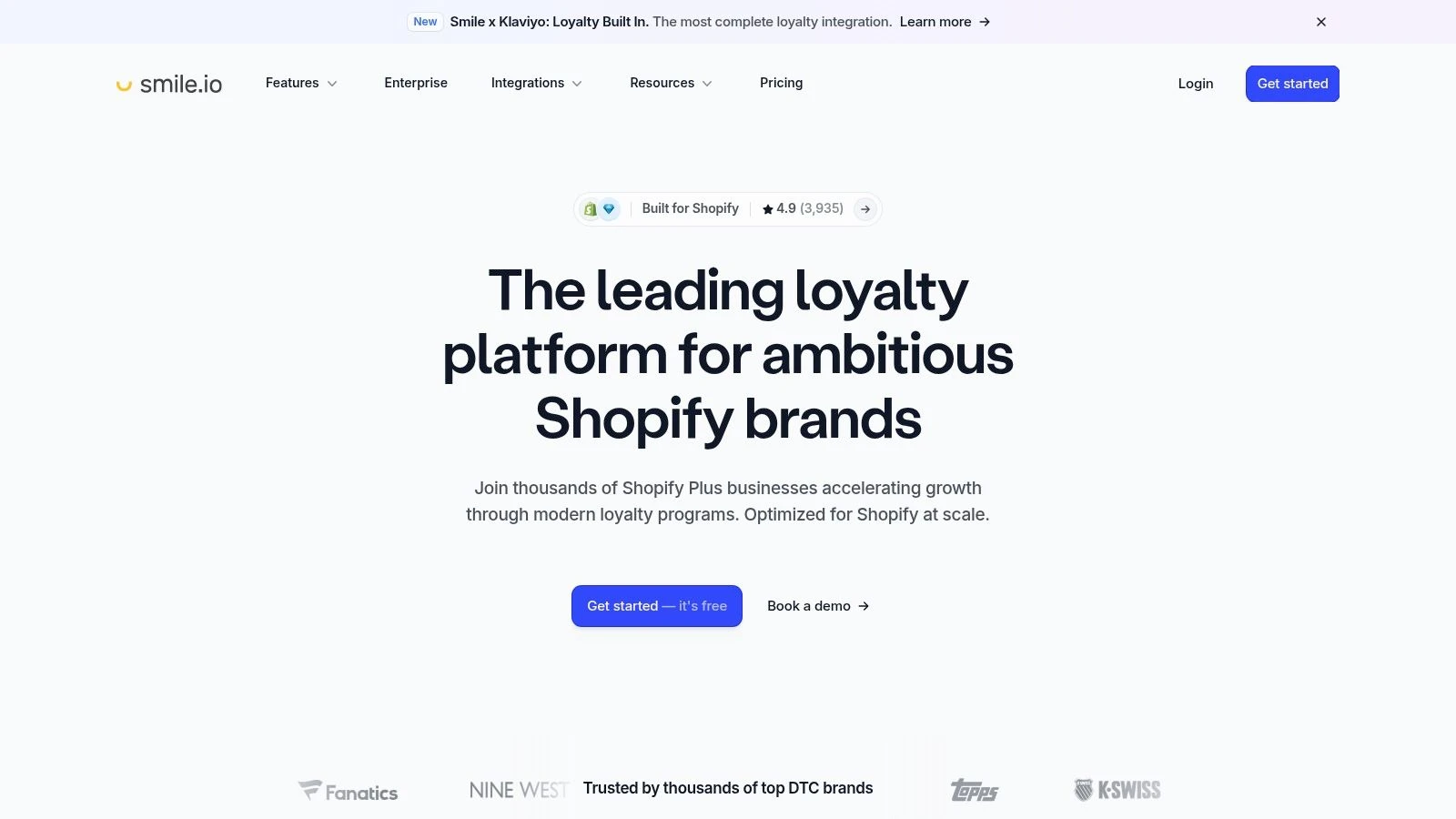
Unlike broad marketplaces, Smile.io provides a focused look at what works for direct-to-consumer businesses. Their website features case studies and customer stories that reveal the specific tactics brands use to drive engagement and repeat purchases. This makes it an excellent learning tool for business owners who want to implement a proven strategy without extensive trial and error.
Strategic Breakdown & Takeaways
Smile.io is designed for rapid deployment, allowing merchants to launch a functional loyalty program quickly. Its true value for research lies in its transparent structure and the clear examples from its user base, which you can often find by looking at the brands they feature.
- Actionable Tip: Start with Smile.io's free plan to understand the core mechanics of a points-based system. You can set up basic "points for purchase" and "points for account creation" rules to see how customers respond before committing to a paid tier.
- Pricing Insights: Pricing is transparent and based on monthly orders, which is ideal for businesses with fluctuating sales. The clear upgrade path helps you anticipate costs as your business grows, and overage fees are clearly stated.
- Unique Feature: The platform's powerful analytics dashboard provides clear ROI tracking from day one. This helps you justify the investment by directly connecting loyalty program activities to revenue and customer retention metrics.
By exploring brands that use Smile.io, you can gather practical ideas for structuring your own points, referral rewards, and VIP benefits, making it a rich source of inspiration.
Pros & Cons
| Pros | Cons |
|---|---|
| Very fast to launch and intuitive for non-technical users | Some analytics and advanced capabilities require higher paid tiers |
| Transparent pricing with a true free tier to start | Primarily focused on direct-to-consumer ecommerce |
| Good fit for small and medium ecommerce brands | Not ideal for complex B2B or enterprise-level programs |
Website: https://smile.io/
6. G2 - Loyalty Management software category
For business owners wanting to compare loyalty software based on peer feedback, G2’s Loyalty Management category is an essential research hub. This platform functions as a comprehensive buyer’s guide, moving beyond marketing claims to provide real-world customer loyalty program examples through the lens of user experience. It aggregates reviews, feature lists, and company data for hundreds of vendors, from small business solutions to enterprise-level platforms.
Unlike vendor websites, G2 offers an unbiased, third-party perspective. You can filter solutions by company size (Small Business, Mid-Market, etc.) and use its comparison tool to see how different platforms stack up on features like reward structures, campaign management, and analytics. This allows you to evaluate options based on validated user satisfaction rather than just marketing promises.
Strategic Breakdown & Takeaways
G2’s true power lies in its detailed user reviews, which often reveal the practical pros and cons of implementing a specific loyalty program. By reading firsthand accounts, you can learn about ease of use, customer support quality, and the actual ROI businesses are seeing.
- Actionable Tip: Use the "Small-Business" filter to narrow down the options relevant to your scale. Read the lowest-rated reviews (1-3 stars) for a potential vendor to understand its biggest weaknesses and potential deal-breakers.
- Pricing Insights: While G2 doesn’t list direct pricing, the reviews and vendor profiles often indicate the general pricing tier. This helps you shortlist vendors within your budget before you engage in a sales conversation.
- Unique Feature: The side-by-side comparison matrix lets you select up to four vendors and directly compare their features, supported integrations, and satisfaction ratings in a clean, easy-to-read format.
This peer-review-driven approach helps you build a robust shortlist and understand the market landscape. To implement your chosen platform effectively, you need strong tactics. Discover more by reading about top strategies for customer retention on BonusQR.com.
Pros & Cons
| Pros | Cons |
|---|---|
| Access to authentic user reviews and unfiltered feedback | Vendor pages can be marketing-heavy and less about direct use |
| Free to browse and research a wide array of loyalty platforms | Detailed info or reports may be gated behind lead forms |
| Powerful comparison tools to evaluate vendors side-by-side | The platform is a research tool, not a direct purchase marketplace |
Website: https://www.g2.com/categories/loyalty-management
7. Amazon - Books on loyalty program examples and playbooks
For small business owners who prefer a deep, strategic understanding before implementation, Amazon's vast library is an underrated resource for finding detailed customer loyalty program examples. Instead of focusing on software, this approach prioritizes learning from comprehensive playbooks, case studies, and strategy guides written by industry experts. It's a goldmine for understanding the "why" behind successful programs, not just the "how."
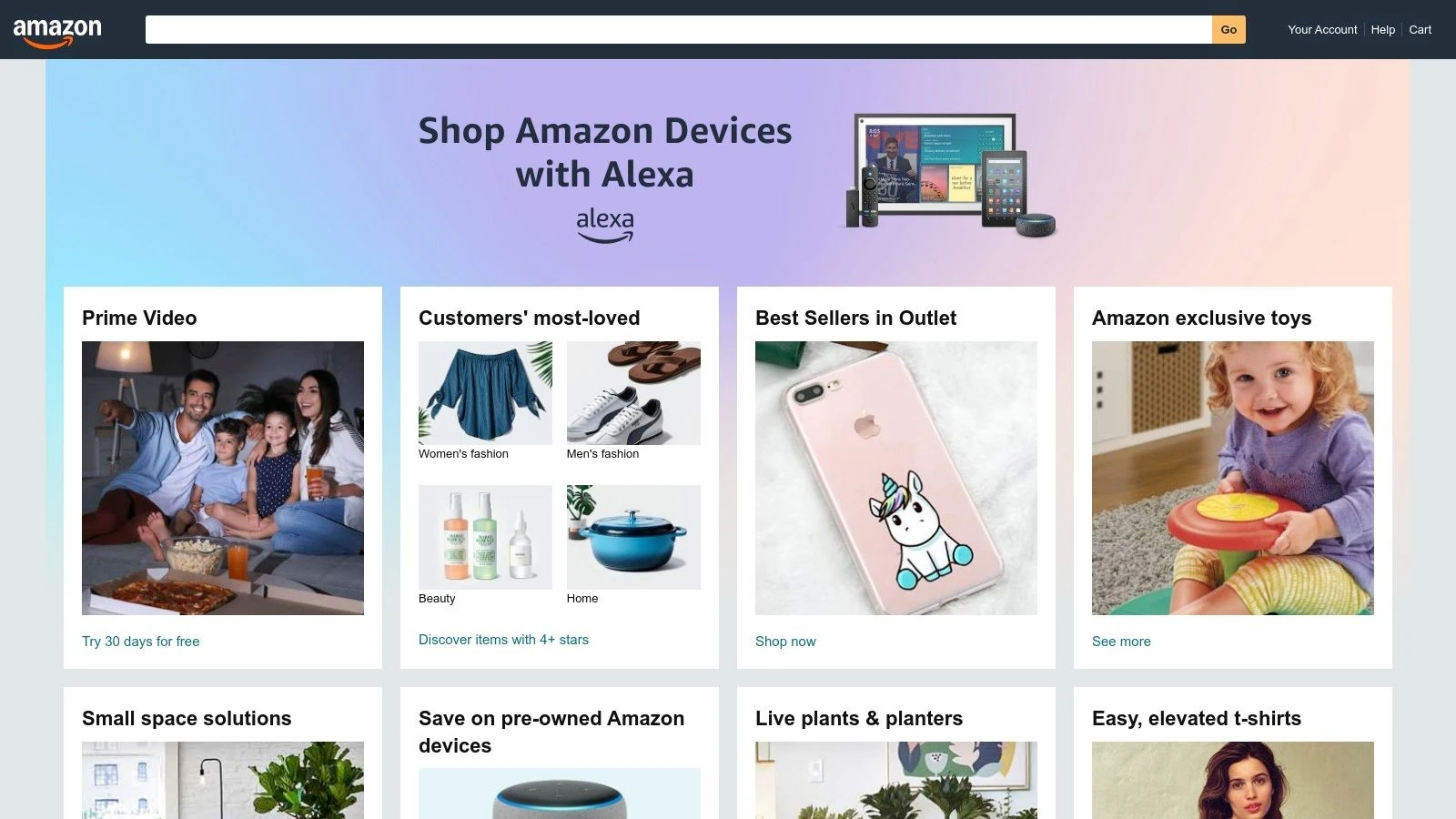
Unlike browsing software platforms, books offer a curated, in-depth analysis of loyalty archetypes and design principles that transcend specific industries. You can find both classic and modern titles covering everything from the psychology of rewards to the financial modeling of a points system. User reviews provide a valuable filter, helping you identify which books offer practical, actionable advice versus purely theoretical concepts.
Strategic Breakdown & Takeaways
The primary advantage of using Amazon is the ability to build a foundational strategy that is platform-agnostic. By studying various models and case studies, you can design a program tailored to your specific business goals, whether you run a café, salon, or local retail shop, before you even consider technology.
- Actionable Tip: Use specific search terms like "customer retention playbook," "loyalty program case studies," or "restaurant rewards strategy" to uncover niche titles. Use the "Look Inside" feature to preview the table of contents and introduction to gauge if the book’s content aligns with your needs.
- Pricing Insights: The cost of a book (often available in affordable Kindle format) is a small investment for a comprehensive education in loyalty strategy. This knowledge can save thousands in misguided software choices or poorly designed programs.
- Unique Feature: Many authors provide supplementary materials like downloadable templates, worksheets, or checklists, turning a passive reading experience into an active strategic planning session for your business.
This educational approach ensures your loyalty program is built on a solid strategic foundation, increasing its chances of long-term success. It's about crafting a well-thought-out plan rather than just picking a popular app.
Pros & Cons
| Pros | Cons |
|---|---|
| Cost-effective way to study dozens of real-world examples | Content is static; no interactive software or ready-to-use tools |
| Wide availability in multiple formats (Kindle, paperback) | Quality varies; must vet authors and read reviews carefully |
| Great for strategy and template inspiration beyond software | Slower to implement than an out-of-the-box software solution |
Website: https://www.amazon.com
Top 7 Customer Loyalty Program Examples Comparison
| Product/Resource | Implementation Complexity | Resource Requirements | Expected Outcomes | Ideal Use Cases | Key Advantages |
|---|---|---|---|---|---|
| BonusQR | Moderate; easy setup under 5 mins, some advanced features complex | Low to moderate; no hardware or POS needed; higher cost for custom apps | High engagement through customizable loyalty and marketing automation | Small businesses like cafes, salons, gyms needing flexible loyalty | Highly customizable programs; strong analytics; marketing automation |
| Shopify App Store - Customer Loyalty | Low; app install and testing straightforward | Variable; many free trials/plans available | Varied, depends on chosen app | Shopify merchants exploring or adopting loyalty apps | Wide selection; real user reviews; easy direct install |
| Square Loyalty | Low; native integration with Square POS | Low; included with Square POS system | Good for quick in-store omnichannel loyalty | US restaurants and retailers using Square ecosystem | Fast launch; simple enrollment; usage-based pricing |
| Yotpo Loyalty & Referrals | Moderate-high; setup can be time-consuming for advanced | Moderate to high; pricing scales with order volume | Strong results shown in case studies; scalable | Ecommerce stores, mid to large size on Shopify and others | Rich case studies; integrated marketing ecosystem |
| Smile.io | Low; user-friendly, quick launch | Low; transparent pricing, free tier available | Effective for SMB ecommerce loyalty growth | Small to medium ecommerce brands on Shopify, Wix, BigCommerce | Intuitive; transparent pricing; good for SMBs |
| G2 - Loyalty Management software | Low; browsing and comparison only | None; free access | Insightful vendor comparisons and user feedback | Buyers researching loyalty software across SMB to enterprise | Authentic user reviews; broad vendor coverage |
| Amazon - Books on Loyalty Programs | None; purely study and learning | Low; purchase of books | Knowledge gain and strategic insight | Professionals and businesses seeking in-depth loyalty program knowledge | Cost-effective; wide variety; deep strategic content |
Putting These Examples Into Action: Your Next Steps
We've analyzed a wide array of customer loyalty program examples, from dedicated tools like Smile.io and Square Loyalty to the vast ecosystems found in the Shopify App Store and G2's software directories. The journey through these examples reveals a powerful, unifying theme: the most effective loyalty programs are not generic templates but are instead tailored instruments designed to resonate with a specific customer base and achieve clear business objectives.
The difference between a program that just gives away discounts and one that builds a genuine community lies in strategy. A local coffee shop's goal of increasing morning rush frequency is fundamentally different from an online salon supplier aiming to boost average order value. The key is to start with your "why" before you decide on the "how".
From Inspiration to Implementation
To turn these insights into a tangible asset for your business, follow this strategic roadmap. This process ensures you build a program with purpose, not just features.
- Define Your Core Objective: What is the single most important outcome you want? Is it higher customer lifetime value, more frequent visits, or a steady stream of referrals? Write it down. A clear goal is the foundation of a successful program.
- Understand Your Customer's Motivation: Why do your customers choose you? Is it convenience, quality, community, or price? Your rewards should align with these motivations. If they value unique experiences, a simple points-for-cash system might fall flat.
- Assess Your Operational Capacity: Be realistic about what you and your team can manage. A complex, tiered program might sound impressive, but a simple, flawlessly executed digital punch card from a tool like BonusQR could deliver better results with less overhead.
Choosing the Right Tool for the Job
Your choice of software should be a direct consequence of the strategic decisions made above. As you sift through the different loyalty program examples and platforms, consider these critical factors:
- Ease of Use: How quickly can your staff learn the system? How intuitive is it for your customers to join and redeem rewards? A complicated process is a major barrier to adoption.
- Integration: Does the tool connect seamlessly with your existing Point of Sale (POS) system, e-commerce platform, or marketing software? Poor integration creates manual work and a disjointed customer experience.
- Scalability: Will this program grow with your business? Consider whether the platform can support future goals, like adding more locations, launching an online store, or implementing more sophisticated reward tiers.
By grounding your decision in strategy, you move beyond just picking a tool and start building a powerful engine for growth. As you move forward, you can explore comprehensive strategies for creating a customer loyalty program that truly resonates with your audience. Remember, a loyalty program is a dynamic conversation with your most valuable customers; it's an investment that, when done right, pays dividends for years to come.
Ready to launch a loyalty program that is both powerful and incredibly simple to manage? BonusQR provides an all-in-one solution designed specifically for small businesses, combining digital punch cards, rewards, and customer communication in a single, user-friendly platform. See how you can build lasting customer relationships by starting with BonusQR today.
